Streatham
Streatham (/ˈstrɛt.əm/ STRET-əm) is a district mostly in the London Borough of Lambeth in Greater London, but with some areas to the west stretching out into the neighbouring London Borough of Wandsworth, and some areas to the south stretching out into the neighbouring London Borough of Croydon. It is centred 5 miles (8.0 km) south of Charing Cross. The area is identified in the London Plan as one of 35 major centres in Greater London.[2]
| Streatham | |
|---|---|
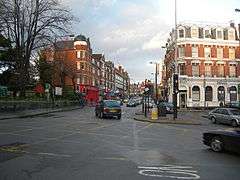 Streatham High Road, looking north from the junction of Streatham High Road and Mitcham Lane | |
 Streatham Location within Greater London | |
| Population | 58,055 (2011 Census)[1] |
| OS grid reference | TQ305715 |
| Ceremonial county | Greater London |
| Region | |
| Country | England |
| Sovereign state | United Kingdom |
| Post town | LONDON |
| Postcode district | SW2, SW16 |
| Dialling code | 020 |
| Police | Metropolitan |
| Fire | London |
| Ambulance | London |
| UK Parliament | |
History
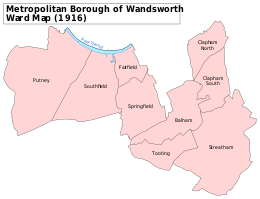
Streatham means "the hamlet on the street". The street in question, the London to Brighton Way, was the Roman road from the capital Londinium to the south coast near Portslade, today within Brighton and Hove. It is likely that the destination was a Roman port now lost to coastal erosion, which has been tentatively identified with 'Novus Portus' mentioned in Ptolemy's Geographia.[3] The road is confusingly referred to as Stane Street (Stone Street) in some sources and diverges from the main London-Chichester road at Kennington.
After the departure of the Romans, the main road through Streatham remained an important trackway. From the 17th century it was adopted as the main coach road to Croydon and East Grinstead, and then on to Newhaven and Lewes. In 1780 it then became the route of the turnpike road from London to Brighton, and subsequently became the basis for the modern A23. This road (and its traffic) have shaped Streatham's development.
Streatham's first parish church, St Leonard's, was founded in Saxon times but an early Tudor tower is the only remaining structure pre-dating 1831 when the body of the church was rebuilt. The mediaeval parish covered a wider area including Balham and Tooting Bec.[4]
Streatham appears in Domesday Book of 1086 as Estreham. It was held by Bec-Hellouin Abbey (in Normandy) from Richard de Tonbrige. Its domesday assets were: 2 hides, 1 virgate and 6½ ploughlands of cultivated land and 4 acres (1.6 ha) of meadow and herbage (mixed grass and bracken). Annually it was assessed to render £4 5s 0d to its overlords.[5]
Streatham Village and Streatham Wells
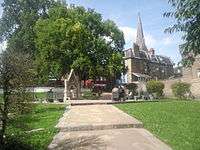
The village remained largely unchanged until the 18th century, when its natural springs, known as Streatham Wells, were first celebrated for their health-giving properties. The reputation of the spa, and improved turnpike roads, attracted wealthy City of London merchants and others to build their country residences in Streatham.[6]
In spite of London's expansion, a limited number of developments took place in the village in the second half of the nineteenth century, most notably on Wellfield Road and Sunnyhill Road. These roads are today considered an important part of what remains of the historic Streatham village.
Wellfield Road, which had previously been known as Leigham Lane, was renamed to reflect its role as the main route from the village centre to one of the well locations. Another mineral well was located on the south side of Streatham Common, in an area that now forms part of The Rookery.[7]
Streatham Park or Streatham Place
In the 1730s, Streatham Park, a Georgian country mansion, was built by the brewer Ralph Thrale on land he bought from the Lord of the Manor - the fourth Duke of Bedford. Streatham Park later passed to Ralph's son Henry Thrale, who with his wife Hester Thrale entertained many of the leading literary and artistic characters of the day, most notably the lexicographer Samuel Johnson. The dining room contained 12 portraits of Henry's guests painted by his friend Joshua Reynolds. These pictures were wittily labelled by Fanny Burney as the Streatham Worthies.[8]
Streatham Park was later leased to Prime Minister Lord Shelburne, and was the venue for early negotiations with France that led to the Peace Treaty of 1783. Streatham Park was demolished in 1863.
Park Hill
One large house that survives is Park Hill, on the north side of Streatham Common, rebuilt in the early 19th century for the Leaf family. It was latterly the home of Sir Henry Tate, sugar refiner, benefactor of local libraries across south London, including Streatham Library, and founder of the Tate Gallery at Millbank.
Urbanisation
Development accelerated after the opening of Streatham Hill railway station on the West End of London and Crystal Palace Railway in 1856. The other two railway stations followed within fifteen years. Some estates, such as Telford Park to the west of Streatham Hill, were spaciously planned with facilities like tennis clubs.[9] Despite the local connections to the Dukes of Bedford, there is no link to the contemporary Bedford Park in west London. Another generously sized development was Roupell Park, the area near Christchurch Road promoted by the Roupell family. Other streets adopted more conventional suburban layouts. Three more parish churches were built to serve the growing area, including Immanuel and St Andrew's (1854), St Peter's (1870) and St Margaret the Queen's (1889). There is now a mixture of buildings from all architectural eras of the past 200 years.
The inter-war period
After the First World War Streatham developed as a location for entertainment, with Streatham Hill Theatre (now a bingo hall), three cinemas, the Locarno ballroom (latterly Caesar's nightclub, which closed in 2010) and Streatham Ice Rink all adding to its reputation as "the West End of South London". With the advent of electric tram services it also grew as a shopping centre serving a wide area to the south. In the 1930s large numbers of blocks of flats were constructed along the High Road. These speculative developments were not initially successful. They were only filled when émigré communities began to arrive in London after leaving countries under the domination of Hitler's Germany. In 1932 the parish church of the Holy Redeemer was built in Streatham Vale to commemorate the work of William Wilberforce.[10]
Retail decline and recovery
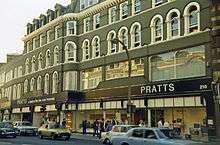
In the 1950s Streatham had the longest and busiest shopping street in south London. Streatham became the site of the UK's first supermarket, when Express Dairies Premier Supermarkets opened its first 2,500 square feet (230 m2) store in 1951;[12] Waitrose subsequently opened its first supermarket in Streatham in 1955, but it closed down in 1963.[13]
However, a combination of factors led to a gradual decline through the 1970s and a more rapid decline in the 1980s. These included long term population movements out to Croydon, Kingston and Sutton; the growth of heavy traffic on the A23 (main road from central London to Gatwick Airport and Brighton); and a lack of redevelopment sites in the town centre. This culminated in 1990 when the closure of Pratts, which had grown from a Victorian draper's shop to a department store operated since the 1940s by the John Lewis Partnership, coincided with the opening of a large Sainsbury's supermarket half a mile south of the town centre, replacing an existing, smaller Sainbury's store opposite Streatham Hill railway station.
Several recent additions, such as Argos, Lidl and Peacocks, are located in new retail spaces on the site of Pratt's but, in common with other high streets, retail recovery has been slow, and a substantial proportion of vacant space has been taken by a growing number of restaurants, bars and coffee shops.
In August 2011, Streatham was selected as one of the areas to benefit from Round 1 of the Mayor of London's Outer London Fund, gaining £300,000. Later, Streatham was awarded a further £1.6 million, matched by another £1 million by Lambeth.[14] The money from this fund was spent on improving streets and public spaces in Streatham. This includes the smartening up of shop fronts through painting and cleaning, replacing shutters and signage as well as helping to reveal facilities behind the high street such as The Stables Community Centre.[15] Streatham Library has also undergone a £1.2 million refurbishment. The Tudor Hall behind the library was brought back into public use as The Mark Bennett Centre providing a meeting and performance space. Streatham Skyline introduced new lighting to highlight some of Streatham's more attractive buildings and monuments with the aim of improving safety and the overall attractiveness of the area.[15]
Contemporary Streatham
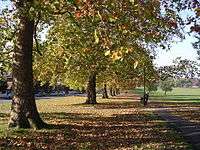
In September 2002, Streatham High Road was voted the "Worst Street in Britain"[16] in a poll organised by the BBC Today programme and CABE. This largely reflected the dominance of through traffic along High Road.
Plans for investment and regeneration had begun before the poll, with local amenity group the Streatham Society leading a successful partnership bid for funding from central government for environmental improvements. Work started in winter 2003–04 with the refurbishment of Streatham Green and repaving and relighting of the High Road between St Leonard's Church and the Odeon Cinema. In 2005 Streatham Green won the Metropolitan Public Gardens Association 'London Spade' award for best public open space scheme in the capital.
The poll was a catalyst for Lambeth London Borough Council and Transport for London's Street Management to co-operate on a joint funding arrangement for further streetscape improvements, which benefited the section of the High Road between St Leonard's and Streatham station, and the stretch north of the Odeon as far as Woodbourne Avenue. The section between Woodbourne Avenue and Streatham Hill station was not completed until 2015. Any further improvements north of Streatham Hill have been halted because of TfL's budgetary shortfall.
Streatham Festival was established in 2002. It has grown to a festival with over 50 events held in an array of locations, from bars to churches and parks to youth centres, attracting over 3,000 people.[17]
After several years of delay and controversy over phasing, construction started in the autumn of 2011 on the Streatham Hub - a major redevelopment next to Streatham railway station. The project was a joint development by Lambeth Council and Tesco. The project involved the demolition of Streatham Ice Arena, Streatham Leisure Centre and the former Streatham Bus Garage, and their replacement with a new leisure centre and a Tesco store with 250 flats above it. Streatham Leisure Centre closed in November 2009 due to health and safety concerns when part of the pool hall ceiling collapsed.[18] Streatham Ice Arena closed on 18 December 2011, having celebrated eighty years of operation in February 2011. For two years a temporary ice rink was provided at Popes Road, Brixton.
In November 2013, the new Streatham Ice and Leisure Centre opened to the public.[19] The leisure centre houses a 60 m x 30 m indoor ice rink with 1,000 rink-side seats on the upper floors,[20] a six-lane 25 m swimming pool, 13 m teaching pool, four-court sports hall and a gym with 100 stations.
The jazz venue Hideaway continues Streatham's long entertainment tradition. It features live performances of jazz, funk, swing and soul music as well as stand-up comedy nights. It won the Jazz Venue/Promoter of the Year category in the 2011 Parliamentary Jazz Awards.[21]
2020 stabbing attack
On 2 February 2020 at around 14:00 GMT, Sudesh Mamoor Faraz Amman attacked and injured two people using a machete on Streatham High Street in what police have declared a terrorist incident.[22] Alongside the machete, Amman was also wearing a vest with components made to look like improvised explosive devices.[23] He was pursued by armed police and was fatally shot outside a Boots pharmacy.[24]
Administration
Streatham is covered by Lambeth London Borough Council and lies within the parliamentary constituency of the same name.
Education
- Bishop Thomas Grant School
- Dunraven School
- Streatham & Clapham High School
- London Steiner School
- Sunnyhill Primary School
- Hitherfield Primary School
- Streatham Wells Primary School
- St Andrews RC Primary School
- Eardley Primary School (Wandsworth)
- Penwortham Primary School (Wandsworth)
- St Leonard's Primary School
- Broomwood Hall Lower School
- Henry Cavendish Primary School (Streatham campus)
- Woodmansterne Primary School
Sport
- Streatham RedHawks (ice hockey)
- London Warriors (American football)
- South London Storm (rugby league)
- Streatham-Croydon RFC
Places of worship
- St Leonard's Church (Church of England) - the historic parish church
- English Martyrs' Church (Roman Catholic) - located opposite St Leonard's - it is the second of Streatham's "twin spires"
- Christ Church, Streatham Hill (Church of England)
- Holy Redeemer Church, Streatham Vale (Church of England)
- St Margaret the Queen, Cricklade Avenue, Streatham Hill (Church of England)
- St Peter's Church, Streatham (Church of England)
- St Simon and St Jude, Hillside Road, Streatham Hill (Roman Catholic)
- Streatham Baptist Church, Lewin Road
- Hambro Road Baptist Church
- Streatham Methodist Church, Riggindale Road
- New Covenant Church, Pendennis Road
- Islamic Centre, Estreham Road (Shi’a)
- Streatham Friends Meeting House, Roupell Park Estate (Religious Society of Friends (Quakers))
- Streatham Mosque, Mitcham Lane (Sunni)
- Streatham Hill Mosque, Norfolk House Road (Sunni)
- South London Synagogue, Leigham Court Road (United Synagogue)
- South London Liberal Synagogue, Prentis Road (Liberal Judaism)
- Hitherfield Road Baptist Church Streatham {SW16 2LN}
- St James' Streatham, Mitcham Lane (SW16 6NT)
- Mitcham Lane Baptist Church, Mitcham Lane (SW16 6NT)
- St Albans - Evangelical, Pretoria Road (SW16 6RR)
- Streatham Central Church, Wellfield Road (SW16 2BP)
Notable residents
Among the people who were born, lived or worked in Streatham, or are otherwise associated with the area are:
- Arthur Anderson, P&O founder, and Liberal Radical MP[25]
- Lynda Baron, actor[26]
- Jonathan Bartley, co-leader of the Green Party
- Giuseppe Baretti, linguist[27]
- Arnold Bax, composer[28]
- Sarah Beeny, television presenter[29][30]
- Floella Benjamin, actress and TV presenter
- Hywel Bennett, actor[31]
- Ian Bostridge, Tenor
- Mark Bostridge, Writer
- Bernard Braden, Actor and TV personality
- Druce Brandt, cricketer
- Henry Robertson Bowers, explorer
- Edmund Burke, philosopher
- Charles Burney, composer and music historian
- Frances Burney, novelist and playwright
- Simon Callow, actor[32][33]
- Naomi Campbell, model
- Geoffrey Cather, Victoria Cross-winning soldier[34]
- Christopher Chessun, bishop of Southwalk- official residence in Streatham
- Nicholas Clay, actor[35]
- Lionel Crabb, George Medal recipient[36]
- Aleister Crowley[37]
- Dave, rapper
- Carl Davis, composer[38]
- Peter Davison, actor[39]
- Kevin Day, comedian
- Henry Doulton, Founder Royal Doulton[40]
- Siobhan Dowd, author[41]
- William Dring, Portrait Artist, RA
- William Dyce, artist, professor
- Hester Maria Elphinstone, Viscountess Keith, literary correspondent
- Paul England, actor, director, and author, born in Streatham[42]
- Edward Foster, Victoria Cross
- John Galliano, fashion designer[43]
- George Galloway, former MP
- David Garrick, actor
- Edward Stanley Gibbons, philatelist
- Oliver Goldsmith, novelist, playwright and poet
- Grooverider, DJ[44]
- Isidore Gunsberg, Chess master[45]
- David Gurr, author
- Derek Guyler, actor[46]
- Jeremy Hardy, comedian[47]
- David Harewood, actor[48]
- Sir Norman Hartnell, royal dressmaker
- Patricia Hayes, actor
- Hy Hazell, actress[49]
- Sir Arthur Helps, Writer
- Benjamin Hoadley, Bishop
- Glyn Hodges, professional footballer and manager
- Roy Hudd, comedian and TV personality
- Rachel Hurd-Wood, actor
- Eddie Izzard, comedian and actor[50]
- David Jacobs, TV and radio presenter
- Alan Johnson, MP
- Frederick Henry Johnson, Victoria Cross
- Dr Samuel Johnson, author and lexicographer
- Sadiq Khan, Mayor of London[51]
- Zardad Khan, Afghan warlord[52][53]
- Mark King, musician[54]
- Arthur Moore Lascelles, Victoria Cross
- Benny Lee, entertainer[55]
- Ken Livingstone, former MP and former Mayor of London[56]
- John Major, Prime Minister 1990-97, lived at Primrose Court 1969-74[57]
- Horace Brooks Marshall, Lord Mayor of London
- Ken Mackintosh, dance band leader[58]
- Donald McGill, seaside postcard artist
- Cathy McGowan, television presenter[59][60]
- Paul Merton, comedian[61]
- Roger Moore, actor[62]
- Naga Munchetty, TV Presenter
- VS Naipaul, nobel prizewinner literature[63]
- Rudy Narayan, barrister and civil rights activist[64]
- Belgrave Ninnis, Explorer, Doctor
- Belgrave Edward Sutton Ninnis, Explorer, Royal Fusiliers
- David Nixon, TV magician[46]
- Steven Norris, former MP and London Mayoral Candidate[65]
- Daphne Park, Baroness and British Spy
- Cynthia Payne, celebrity madame[66][67]
- Horatio Frederick Phillips, aviation pioneer[68]
- Alistair Pirrie, TV presenter
- Patricia Plunkett, actor
- Steve Reed, MP[69]
- Sir Joshua Reynolds, artist
- Geoffrey Rimbault, first-class cricketer and British Army officer
- Catherine Russell, actor
- Arthur Sanders, WW2 RAF Commander, Air Chief Marshal
- Duncan Sandys, Lord, MP
- Leslie Scarman, Baron Scarman, Law Lord
- Lord Shelburne, prime minister
- Alan Simpson, Comedy script writer[70]
- Arnold Spencer-Smith, explorer
- Michaela Strachan, TV presenter and actress[71]
- Graham Sutherland, artist
- Henry Tate, sugar merchant and philanthropist
- Shaw Taylor, actor and TV presenter[46]
- Hester Thrale, author and patron of the arts
- Henry Thrale, MP and brewer
- Nina Toussaint-White, actress[72][73]
- John Torode, chef and TV presenter[74]
- Stan Tracey, jazz musician[75]
- Tommy Trinder, comedian[76]
- Leonora Tyson, suffragist
- Chuka Umunna, former Labour and Liberal Democrat MP[77]
- Dennis Wheatley, author[78]
- June Whitfield, actress[79]
- W. P. D. Wightman FRSE (1899-1983) scientific author
- Bill Wyman, musician[80]
- Andy Zaltzman, comedian[81]
Nearest places
Nearest railway stations
- Balham station Northern Line and National Rail
- Brixton tube station Victoria Line
- Norbury railway station
- Streatham Common railway station
- Streatham Hill railway station
- Streatham railway station
- Tooting Bec tube station Northern Line
References
- Streatham is made up of 4 wards in the London Borough of Lambeth: St Leonard's, Streatham Hill, Streatham South, and Streatham Wells. "Archived copy". Archived from the original on 22 February 2014. Retrieved 9 June 2014.CS1 maint: archived copy as title (link)
- Mayor of London (February 2008). "London Plan (Consolidated with Alterations since 2004)" (PDF). Greater London Authority. Archived from the original (PDF) on 2 June 2010.
- "Roman Britain – Organisation".
- H.E. Malden (editor) (1912). "Parishes: Streatham". A History of the County of Surrey: Volume 4. Institute of Historical Research. Retrieved 4 November 2014.CS1 maint: extra text: authors list (link)
- "Surrey Domesday Book". Archived from the original on 30 October 2007.
- Wright, Colin. "A View on the Hill near the Five-Mile Stone on the Road to Streatham". www.bl.uk.
- "The Suburbanisation of Streatham - Case Studies - Ideal Homes".
- "Streatham Park - Thrale.com".
- Stopford, Vanessa. "Telford Park Estate".
- "The History of The Holy Redeemer Church Streatham".
- "Pratt's, Streatham High Road, Streatham Central". Archived from the original on 4 March 2016. Retrieved 12 December 2018.
- Helen Gregory (3 November 2001). "It's a super anniversary: it's 50 years since the first full size self-service supermarket was unveiled in the UK". The Grocer. Archived from the original on 8 July 2012. Retrieved 30 June 2010.
- "Streatham - closed branch". waitrosememorystore.org.uk.
- "Town centres to receive cash boost". Streatham Guardian. Archived from the original on 20 March 2016. Retrieved 11 December 2011.
- "Archived copy". Archived from the original on 17 April 2014. Retrieved 1 March 2014.CS1 maint: archived copy as title (link)
- "Britons name 'best and worst streets'". BBC. 20 September 2002.
- "The Streatham Festival -".
- "Council closes Streatham swimming pool". Archived from the original on 19 March 2016. Retrieved 31 December 2011.
- "Streatham ice rink and sports centre opens". 18 November 2013 – via www.bbc.co.uk.
- "Streatham Ice and Leisure Centre - Lambeth Council".
- "Winners announced at the Parliamentary Jazz Awards". News and events. PPL. 18 May 2011. Archived from the original on 12 February 2017. Retrieved 13 November 2014.
- "Streatham attacker had been released from jail". BBC News. 2 February 2020. Retrieved 3 February 2020.
- Davies, Caroline; Dodd, Vikram (2 February 2020). "Police shoot man dead after terror-related stabbing attack in Streatham". The Guardian. ISSN 0261-3077. Retrieved 3 February 2020.
- Dodd, Vikram; Sabbagh, Dan; Syal, Rajeev (2 February 2020). "Streatham attacker freed from jail days ago after terror conviction". The Guardian. ISSN 0261-3077. Retrieved 3 February 2020.
- "London walks: Taking a look at the Rookery nook: Streatham's gardens". The Independent. 2 September 1994.
- "Meandering along Telford Avenue". News Shopper. 20 January 2003.
- "Tate Reynolds exhibition,Creation of celebrity-live in tutor to Thrales May 2005".
- Moss, Stephen (11 October 2007). "Building a classical music library: Arnold Bax". The Guardian.
- "Help! Sarah Beeny's burrowing under home". The Daily Telegraph.
- Cavendish, Lucy (11 January 2009). "Interview: Sarah Beeny, TV property expert". The Guardian. London. Retrieved 24 May 2010.
- Collingwood, Charles (31 August 2011). Brian and Me: Life on - and off - The Archers. Michael O'Mara Books. ISBN 9781843177555 – via Google Books.
- "My perfect weekend: Simon Callow, actor, director and writer". The Daily Telegraph.
- "In celebration of Mr Callow; Did you know Simon Callow had directed opera, is a dictionary obsessive and loved to torment his teachers? As he brings a one-man show to Wales, Kathryn Williams reveals some facts about the much-loved actor. - Free Online Library".
- Hallifax, Stuart (3 November 2014). Great War Britain London: Remembering 1914-18. History Press. ISBN 9780750960571 – via Google Books.
- "Nicholas Clay". The Guardian. 30 May 2000.
- "Lionel "Buster" Crabb". Spartacus Educational.
- "Streatham: The luckiest constituents in Britain?".
- Brown, Craig (12 October 2017). "Writing Cynthia Payne's biography – archive, 12 October1982" – via www.theguardian.com.
- "Peter Davison: having another Doctor Who as a son-in-law is rather weird". The Daily Telegraph.
- "Streatham Park Conservation Area Appraisal and Management Strategy: Wandsworth Borough Council- owner of Woodlands in Streatham Park". Archived from the original on 5 April 2018. Retrieved 4 April 2018.
- Fryer, Jonathan (23 August 2007). "Siobhan Dowd". The Guardian.
- "ENGLAND, PAUL" in Who's who in Broadcasting (1933), p. 56
- "Made in Streatham, made it in Paris". The Independent. 22 January 1997.
- "Grooverider - New Songs, Playlists & Latest News". BBC.
- Harding, Tim (6 April 2012). Eminent Victorian Chess Players: Ten Biographies. McFarland. ISBN 9780786465682 – via Google Books.
- Theatre, Streatham (26 January 2014). "A Local Historian's View, 1950s".
- "Jeremy on Jeremy: Comedian Jeremy Hardy talks about Corbyn and his weirdest ever gig".
- Harewood, David (29 April 2012). "Streatham's no s***hole, it's a vibrant place I'm proud to call my home". The Guardian. London. Retrieved 2 May 2013.
- "Source BFI forever, born Streatham".
- "MP shared flat with cross-dressing comedian".
- Fraser, Isabelle (13 May 2016). "Tooting its own horn: Sadiq Khan's home turf is property gold". The Telegraph – via www.telegraph.co.uk.
- "Afghan charged with torture". BBC News.
- "Afghan torture trial begins in UK". BBC News.
- "The Fiver". The Guardian.
- "Benny Lee". Herald Scotland 13 Jan 1996.
- "Ken Livingstone: Profile of former London Mayor". BBC News. 28 April 2016.
- John Major (1999). John Major: The Autobiography. Harper Collins. pp. 50–1.
- Streatham-based Musician Dies
- Pateman, John (1 January 2009). The Ramsden Estate. Lulu.com. ISBN 9780956081285 – via Google Books.
- "THE FIRST TIME I...CILLA BLACK. - Free Online Library".
- "Paul Merton: 'I couldn't have written about my father while he was alive'". The Daily Telegraph.
- "Jo Brand told: Streatham is no laughing matter". The Daily Telegraph.
- "Finding Eden in the streets of Streatham Hill". Times Higher Education (THE). 23 January 2004.
- "CIVIL RIGHTS ACTIVIST RUDY NARAYAN DIES". News Shopper.
- "My London: Steve Norris". 25 May 2004 – via news.bbc.co.uk.
- Campbell, Duncan (16 November 2015). "Cynthia Payne obituary". The Guardian.
- Rawlinson, Kevin (15 November 2015). "Former brothel madam Cynthia Payne dies, aged 82". The Guardian.
- "Horatio Phillips". U.S. Centennial of Flight Commission. Archived from the original on 23 September 2006.
- "I live in Streatham with my partner and our two cats-Steve Reed wordpress biography". 29 October 2010.
- "I lived with my mother in Streatham and Ray used to get the bus over-Galton and Simposon interview-Den of Greek 23 Jan 2009". Archived from the original on 4 April 2018.
- "Guardian March 2009- ...round the corner from Mark King of Level 42....he sold his house to Michaela Strachan".
- "I was a wild child, boasts new EastEnders star Nina Toussaint-White". Daily Record. 16 February 2009.
- "Drink and drugs past of soap star Nina". Free Online Library.
- "My Home: John Torode". The Independent. 24 January 2007.
- "Stan Tracey - obituary". Daily Telegraph. 7 December 2013. ISSN 0307-1235. Retrieved 2 February 2020 – via www.telegraph.co.uk.
- Sweet, Matthew (18 August 2009). "You lucky people: remembering Tommy Trinder". The Guardian.
- Mendick, Robert (16 May 2015). "The tragic past haunting Chuka Umunna" – via www.telegraph.co.uk.
- Burnett, Craig (13 September 2009). "Axe hovers over occult writer's former home". Your Local Guardian. Retrieved 2 February 2020.
- "June Whitfield interview: 'Middle class is still a dirty word in TV'". The Daily Telegraph.
- Hodgkinson, Will (13 June 2015). "Bill Wyman: 'The Stones never forgave me for leaving'". The Times.
- "Andy Zaltzman - Streatham's Political Animal". Your Local Guardian.
Further reading
- Daniel Lysons (1792), "Streatham", Environs of London, 1: County of Surrey, London: T. Cadell
- James Thorne (1876), "Streatham", Handbook to the Environs of London, London: John Murray

